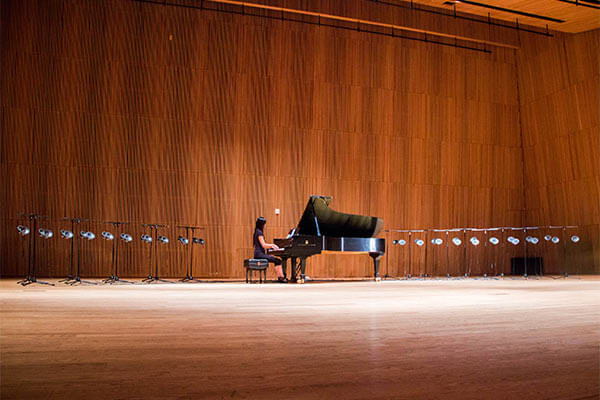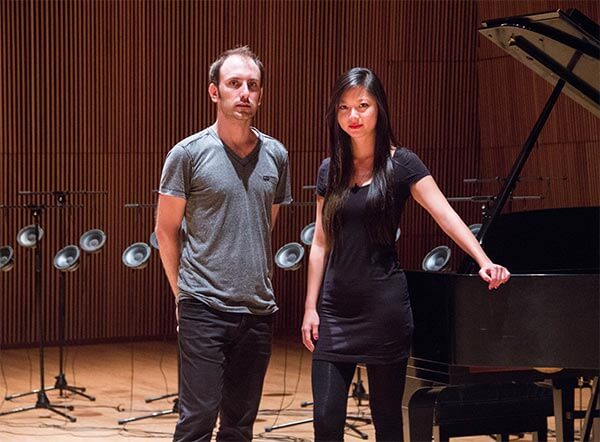The Curtis R. Priem Experimental Media and Performing Arts Center (EMPAC) is a $140 million construction perched atop a hillside within the Rensselaer Polytechnic Institute in Troy, New York. The Music Curator at EMPAC, Argeo Ascani, himself a musician, is likely to extol the facilities at his disposal, which includes access to some of the most acoustically pristine spaces in the world, as well as a team of recording engineers and technicians who are able to realize the full sonic potential of such spaces. There are few locations, it would seem, that would be more suitable to record logistically complex musical material. Surface Image, a new composition for solo piano and 40-channel 1-bit electronics by composer-programmer turned programmer-composer Tristan Perich, is the ideal piece to be realized in such a nest of state-of-the-art creative incubation. It represents the largest scale work of its kind in Perich’s compositional output, and its raison d’être is pianist Vicky Chow, without whom the piece would not exist, as she is both the life-blood of its living performance, and the the person who commissioned it. Together with Argeo Ascani, who also produced this recording of Surface Image, a minimalist tesseract comes to life in a stellar digital release from New Amsterdam Records.

The packaging of this disc is worth mentioning as it is beautifully laid out, delivering a visual cue to understanding the music’s performative complexities even before listening begins: the outside is of a topological grid mesh (resembling those drawings which, crafted by algorithmic processes, Perich often unleashes unto his tiny machines to produce) and on the inside you are confronted by a tri-fold photographic triptych of Vicky Chow seated at the instrument, surrounded by 40 individually placed stands each supporting a single, dangling speaker. It is a wonderful image, alluring enough to beckon one to want to seek out a live performance.
The music of Surface Image is characterized by repeating ostinato figures which gradually morph, swell, subside, and linger, both in the cascade-like figurations and buzzings of the speaker arrays (connected to microprocessors that cause them each to generate a different single 1-bit tone) and in the left/right hand exchanges across the range of the piano. There are phase-shifts, stacks building in abstraction, permutations of voices, subtle modulations, and washes of harmony which dance in a very peculiar way with one another; the almost-abrasive tonal qualities of the speakers (evocative of an English Horn or Bagpipe) stand as a counterweight to Chow’s warm tone and her ability to gradually crescendo into great bursts of activity. Chow, who is a member of the dynamic new music ensemble Bang On A Can All Stars, is no stranger to the type of rhythmical and repetitious style that is required here, as she already possesses a familiarity with the works of Steve Reich, John Adams, and Louis Andriessen, to name but a few. Despite the surface-level uniformity of the sustaining ebbs of rhythm, which belie a sense of simplicity, the overall stamina and precision of her touch is mesmerizing, mimicking the machinic bursts of the electronics at times.
[Tweet “Perich has a fascination with a complete understanding of the mechanics of his microprocessors.”]
Formally, there are at least nine sections, or movements, each of which inhabit a different combinatorial display of interaction. The amorphous quality of its procession makes the junctures between sections hard to decipher — part of Surface Image‘s design as well as its charm — which, as Chow has explained, needs to “be heard as a whole.” Indeed, there is something glacial to its cohesion, and something which speaks to our age of overabundant information flow. Some of the sections ascend into brief but dynamic call-and-response exchanges before the instrumentation regroups and competes to inhabit the same elemental forcefield again. Compositionally, Surface Image is aiming for a seamless blend rather than pitting the acoustic against the electronic. It does so while still allowing for thoughtful play and dialog between lo-fi and hi-fi sonics.

Perich has a fascination with a complete understanding of the mechanics of his microprocessors, and this inside-out working knowledge allows him to directly engage with them. Chow believes that the piano is one of the greatest machines ever created. Together they form an alliance in an ensemble which, having already been explored by numerous composers and performers, nevertheless proves visceral and commanding given the execution delivered by both Chow and Perich, which is presented to us in lush and carefully crafted fidelity by recording engineers Jeffery Svatek and Stephen McLaughlin. Furthermore, with the complex spacial interactions of the speaker’s output and the piano’s often-sustained pedal points, the ability to splice-in anywhere is severely limited, making the long takes needed to realize Surface Image all-the-more virtuosic than it initially seems. As a composer, Perich views programming as a necessity that informs our ideas about interactions we have with the world. This obsession with the rudimentary underpinnings of sound production as it relates to its technological reproduction provides the basis for Surface Image‘s unfolding, and it does so in an unburdened continuity. To categorize this piece as a modern piano concerto would be an overstatement however, as the self-similarity of the speaker’s sonic capabilities and the variety of the sounds derived from within their entirety do not create enough differentiation in the voices, a differentiation most concerti thrive upon. But this is clearly not Perich’s intention. The listener, ready to embrace the oceanic universe Surface Image pivots upon, will discover that it isn’t so much that it should be “listened to”, rather — experienced.
























